Importance of Communication & Health Literacy in Healthcare
VerifiedAdded on 2023/06/07
|8
|2422
|443
Presentation
AI Summary
This assignment is a presentation focusing on the importance of effective communication and health literacy in creating a culturally safe healthcare environment, particularly aimed at orienting new staff. It defines health literacy and effective communication, emphasizing their influence on culturally safe practices. The presentation covers various aspects, including the interrelation of health literacy and communication, cultural factors affecting communication, the role of interpreters, and the benefits of improved health outcomes and patient empowerment. It highlights the need for healthcare providers to be aware of cultural differences and to ensure that care is interpreted as intended. The presentation also incorporates tips for effective PowerPoint presentations, stressing the importance of clear and focused content. The written component underpins the rationale and philosophy behind the presentation, emphasizing the significance of integrating health literacy into education and providing accessible communication to meet diverse customer needs. Ultimately, the goal is to enhance health literacy and communication to improve healthcare outcomes and provide equitable services.
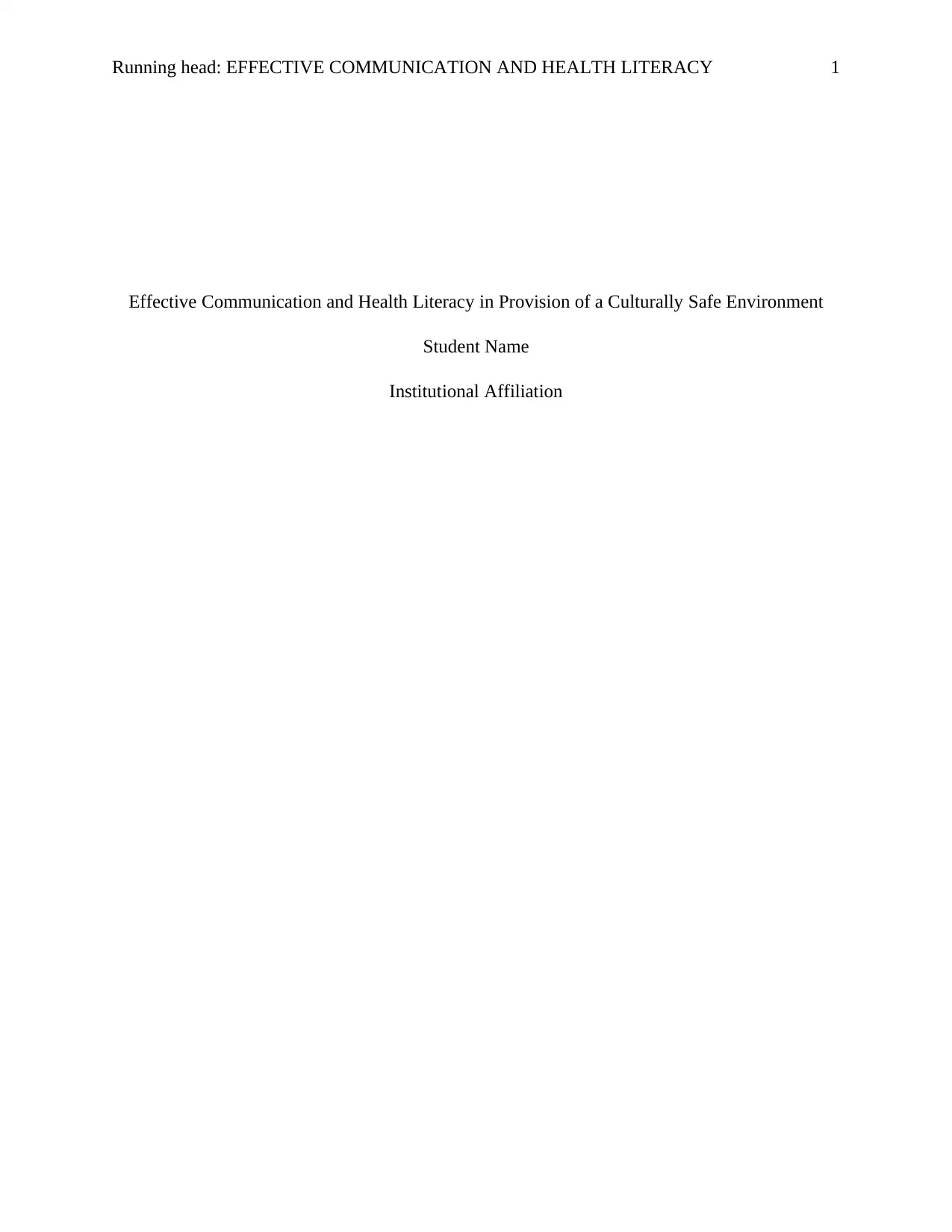
Running head: EFFECTIVE COMMUNICATION AND HEALTH LITERACY 1
Effective Communication and Health Literacy in Provision of a Culturally Safe Environment
Student Name
Institutional Affiliation
Effective Communication and Health Literacy in Provision of a Culturally Safe Environment
Student Name
Institutional Affiliation
Paraphrase This Document
Need a fresh take? Get an instant paraphrase of this document with our AI Paraphraser
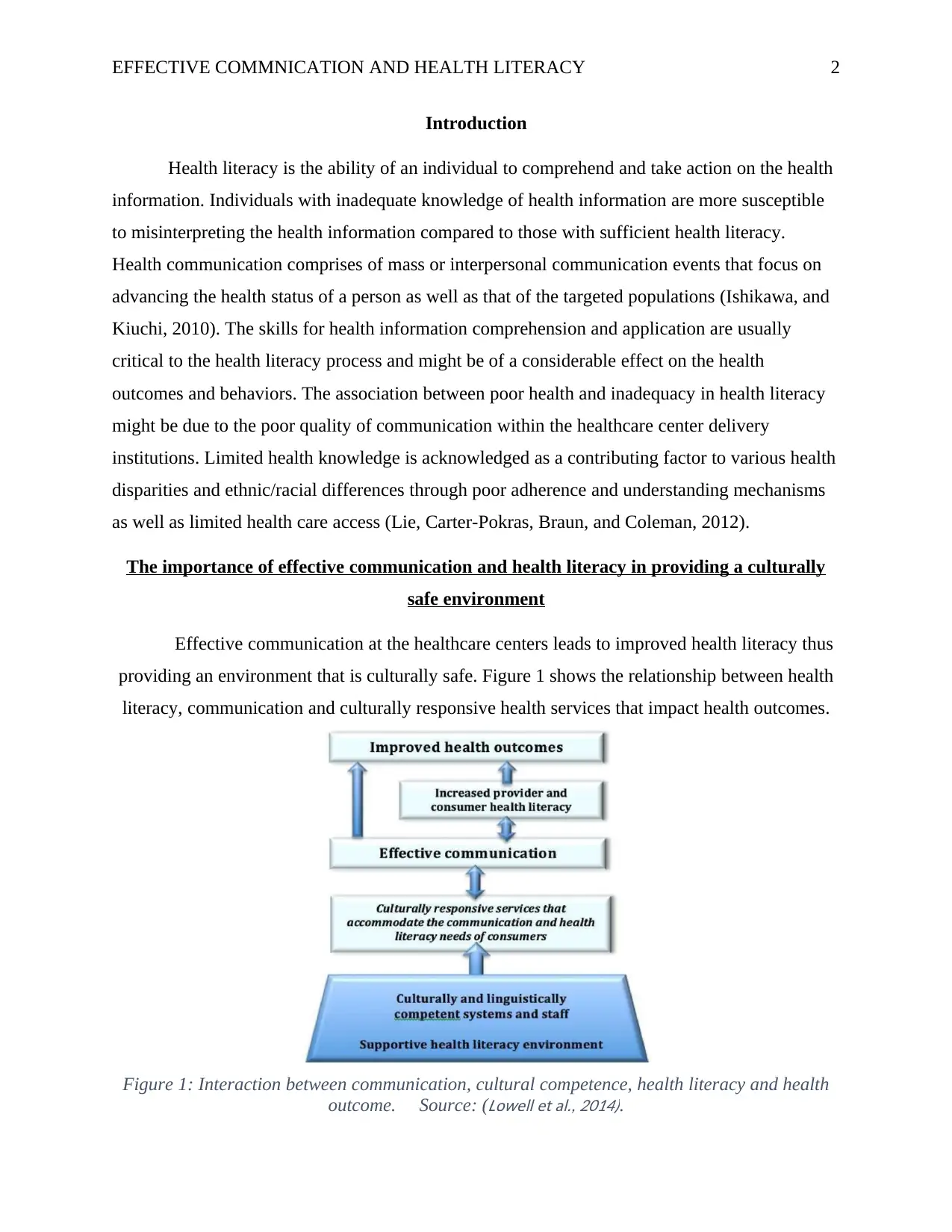
EFFECTIVE COMMNICATION AND HEALTH LITERACY 2
Introduction
Health literacy is the ability of an individual to comprehend and take action on the health
information. Individuals with inadequate knowledge of health information are more susceptible
to misinterpreting the health information compared to those with sufficient health literacy.
Health communication comprises of mass or interpersonal communication events that focus on
advancing the health status of a person as well as that of the targeted populations (Ishikawa, and
Kiuchi, 2010). The skills for health information comprehension and application are usually
critical to the health literacy process and might be of a considerable effect on the health
outcomes and behaviors. The association between poor health and inadequacy in health literacy
might be due to the poor quality of communication within the healthcare center delivery
institutions. Limited health knowledge is acknowledged as a contributing factor to various health
disparities and ethnic/racial differences through poor adherence and understanding mechanisms
as well as limited health care access (Lie, Carter-Pokras, Braun, and Coleman, 2012).
The importance of effective communication and health literacy in providing a culturally
safe environment
Effective communication at the healthcare centers leads to improved health literacy thus
providing an environment that is culturally safe. Figure 1 shows the relationship between health
literacy, communication and culturally responsive health services that impact health outcomes.
Figure 1: Interaction between communication, cultural competence, health literacy and health
outcome. Source: (
o ell et al
L w ., 2014).
Introduction
Health literacy is the ability of an individual to comprehend and take action on the health
information. Individuals with inadequate knowledge of health information are more susceptible
to misinterpreting the health information compared to those with sufficient health literacy.
Health communication comprises of mass or interpersonal communication events that focus on
advancing the health status of a person as well as that of the targeted populations (Ishikawa, and
Kiuchi, 2010). The skills for health information comprehension and application are usually
critical to the health literacy process and might be of a considerable effect on the health
outcomes and behaviors. The association between poor health and inadequacy in health literacy
might be due to the poor quality of communication within the healthcare center delivery
institutions. Limited health knowledge is acknowledged as a contributing factor to various health
disparities and ethnic/racial differences through poor adherence and understanding mechanisms
as well as limited health care access (Lie, Carter-Pokras, Braun, and Coleman, 2012).
The importance of effective communication and health literacy in providing a culturally
safe environment
Effective communication at the healthcare centers leads to improved health literacy thus
providing an environment that is culturally safe. Figure 1 shows the relationship between health
literacy, communication and culturally responsive health services that impact health outcomes.
Figure 1: Interaction between communication, cultural competence, health literacy and health
outcome. Source: (
o ell et al
L w ., 2014).
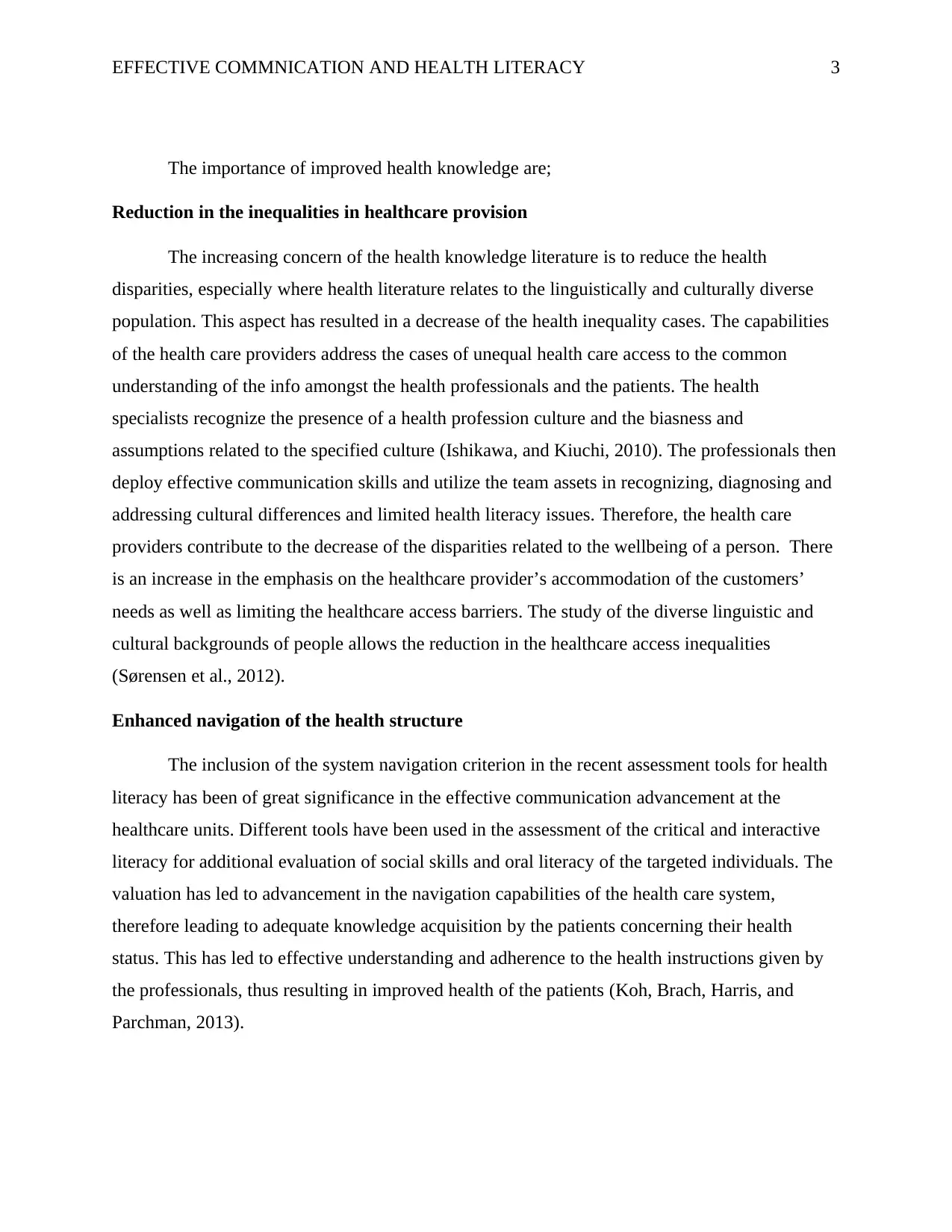
EFFECTIVE COMMNICATION AND HEALTH LITERACY 3
The importance of improved health knowledge are;
Reduction in the inequalities in healthcare provision
The increasing concern of the health knowledge literature is to reduce the health
disparities, especially where health literature relates to the linguistically and culturally diverse
population. This aspect has resulted in a decrease of the health inequality cases. The capabilities
of the health care providers address the cases of unequal health care access to the common
understanding of the info amongst the health professionals and the patients. The health
specialists recognize the presence of a health profession culture and the biasness and
assumptions related to the specified culture (Ishikawa, and Kiuchi, 2010). The professionals then
deploy effective communication skills and utilize the team assets in recognizing, diagnosing and
addressing cultural differences and limited health literacy issues. Therefore, the health care
providers contribute to the decrease of the disparities related to the wellbeing of a person. There
is an increase in the emphasis on the healthcare provider’s accommodation of the customers’
needs as well as limiting the healthcare access barriers. The study of the diverse linguistic and
cultural backgrounds of people allows the reduction in the healthcare access inequalities
(Sørensen et al., 2012).
Enhanced navigation of the health structure
The inclusion of the system navigation criterion in the recent assessment tools for health
literacy has been of great significance in the effective communication advancement at the
healthcare units. Different tools have been used in the assessment of the critical and interactive
literacy for additional evaluation of social skills and oral literacy of the targeted individuals. The
valuation has led to advancement in the navigation capabilities of the health care system,
therefore leading to adequate knowledge acquisition by the patients concerning their health
status. This has led to effective understanding and adherence to the health instructions given by
the professionals, thus resulting in improved health of the patients (Koh, Brach, Harris, and
Parchman, 2013).
The importance of improved health knowledge are;
Reduction in the inequalities in healthcare provision
The increasing concern of the health knowledge literature is to reduce the health
disparities, especially where health literature relates to the linguistically and culturally diverse
population. This aspect has resulted in a decrease of the health inequality cases. The capabilities
of the health care providers address the cases of unequal health care access to the common
understanding of the info amongst the health professionals and the patients. The health
specialists recognize the presence of a health profession culture and the biasness and
assumptions related to the specified culture (Ishikawa, and Kiuchi, 2010). The professionals then
deploy effective communication skills and utilize the team assets in recognizing, diagnosing and
addressing cultural differences and limited health literacy issues. Therefore, the health care
providers contribute to the decrease of the disparities related to the wellbeing of a person. There
is an increase in the emphasis on the healthcare provider’s accommodation of the customers’
needs as well as limiting the healthcare access barriers. The study of the diverse linguistic and
cultural backgrounds of people allows the reduction in the healthcare access inequalities
(Sørensen et al., 2012).
Enhanced navigation of the health structure
The inclusion of the system navigation criterion in the recent assessment tools for health
literacy has been of great significance in the effective communication advancement at the
healthcare units. Different tools have been used in the assessment of the critical and interactive
literacy for additional evaluation of social skills and oral literacy of the targeted individuals. The
valuation has led to advancement in the navigation capabilities of the health care system,
therefore leading to adequate knowledge acquisition by the patients concerning their health
status. This has led to effective understanding and adherence to the health instructions given by
the professionals, thus resulting in improved health of the patients (Koh, Brach, Harris, and
Parchman, 2013).
⊘ This is a preview!⊘
Do you want full access?
Subscribe today to unlock all pages.

Trusted by 1+ million students worldwide
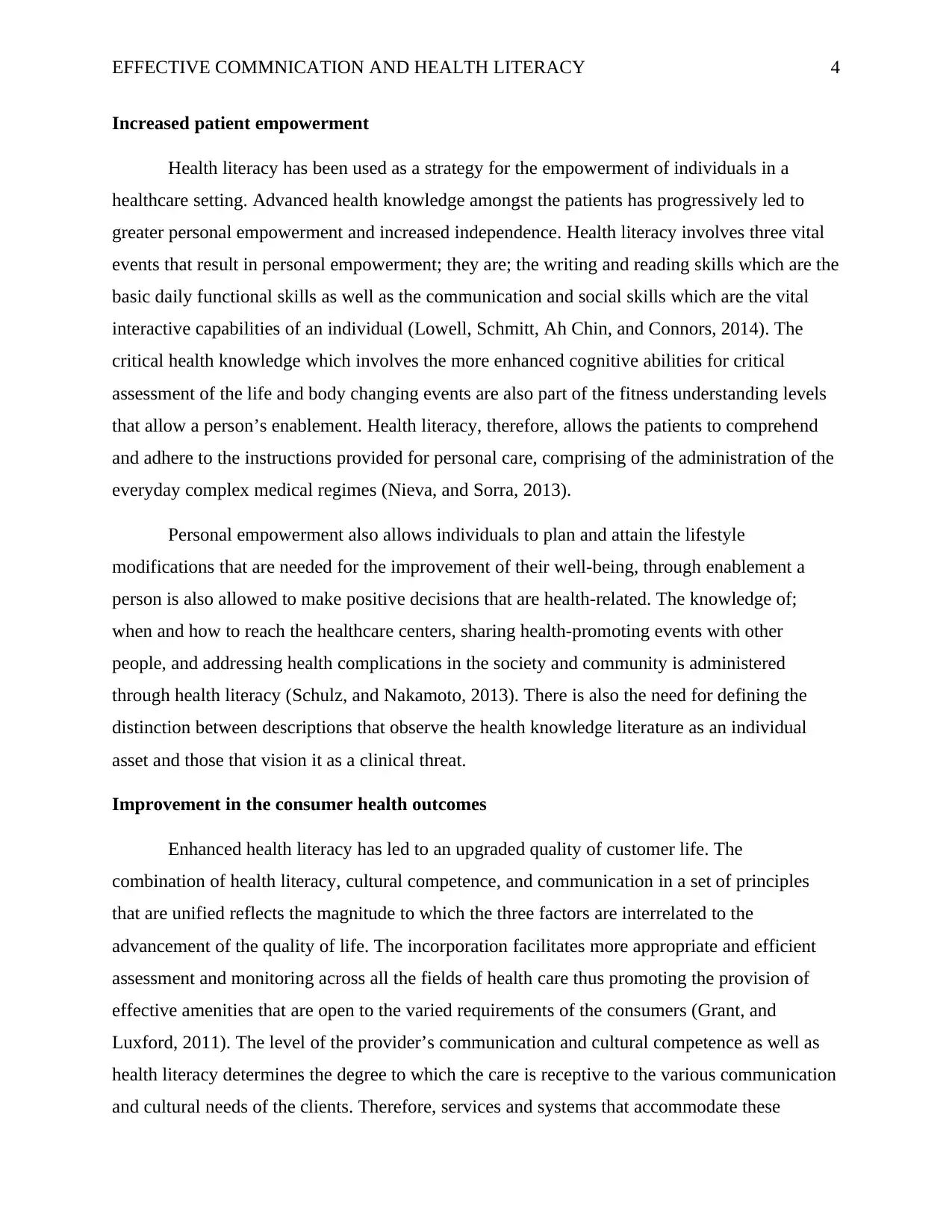
EFFECTIVE COMMNICATION AND HEALTH LITERACY 4
Increased patient empowerment
Health literacy has been used as a strategy for the empowerment of individuals in a
healthcare setting. Advanced health knowledge amongst the patients has progressively led to
greater personal empowerment and increased independence. Health literacy involves three vital
events that result in personal empowerment; they are; the writing and reading skills which are the
basic daily functional skills as well as the communication and social skills which are the vital
interactive capabilities of an individual (Lowell, Schmitt, Ah Chin, and Connors, 2014). The
critical health knowledge which involves the more enhanced cognitive abilities for critical
assessment of the life and body changing events are also part of the fitness understanding levels
that allow a person’s enablement. Health literacy, therefore, allows the patients to comprehend
and adhere to the instructions provided for personal care, comprising of the administration of the
everyday complex medical regimes (Nieva, and Sorra, 2013).
Personal empowerment also allows individuals to plan and attain the lifestyle
modifications that are needed for the improvement of their well-being, through enablement a
person is also allowed to make positive decisions that are health-related. The knowledge of;
when and how to reach the healthcare centers, sharing health-promoting events with other
people, and addressing health complications in the society and community is administered
through health literacy (Schulz, and Nakamoto, 2013). There is also the need for defining the
distinction between descriptions that observe the health knowledge literature as an individual
asset and those that vision it as a clinical threat.
Improvement in the consumer health outcomes
Enhanced health literacy has led to an upgraded quality of customer life. The
combination of health literacy, cultural competence, and communication in a set of principles
that are unified reflects the magnitude to which the three factors are interrelated to the
advancement of the quality of life. The incorporation facilitates more appropriate and efficient
assessment and monitoring across all the fields of health care thus promoting the provision of
effective amenities that are open to the varied requirements of the consumers (Grant, and
Luxford, 2011). The level of the provider’s communication and cultural competence as well as
health literacy determines the degree to which the care is receptive to the various communication
and cultural needs of the clients. Therefore, services and systems that accommodate these
Increased patient empowerment
Health literacy has been used as a strategy for the empowerment of individuals in a
healthcare setting. Advanced health knowledge amongst the patients has progressively led to
greater personal empowerment and increased independence. Health literacy involves three vital
events that result in personal empowerment; they are; the writing and reading skills which are the
basic daily functional skills as well as the communication and social skills which are the vital
interactive capabilities of an individual (Lowell, Schmitt, Ah Chin, and Connors, 2014). The
critical health knowledge which involves the more enhanced cognitive abilities for critical
assessment of the life and body changing events are also part of the fitness understanding levels
that allow a person’s enablement. Health literacy, therefore, allows the patients to comprehend
and adhere to the instructions provided for personal care, comprising of the administration of the
everyday complex medical regimes (Nieva, and Sorra, 2013).
Personal empowerment also allows individuals to plan and attain the lifestyle
modifications that are needed for the improvement of their well-being, through enablement a
person is also allowed to make positive decisions that are health-related. The knowledge of;
when and how to reach the healthcare centers, sharing health-promoting events with other
people, and addressing health complications in the society and community is administered
through health literacy (Schulz, and Nakamoto, 2013). There is also the need for defining the
distinction between descriptions that observe the health knowledge literature as an individual
asset and those that vision it as a clinical threat.
Improvement in the consumer health outcomes
Enhanced health literacy has led to an upgraded quality of customer life. The
combination of health literacy, cultural competence, and communication in a set of principles
that are unified reflects the magnitude to which the three factors are interrelated to the
advancement of the quality of life. The incorporation facilitates more appropriate and efficient
assessment and monitoring across all the fields of health care thus promoting the provision of
effective amenities that are open to the varied requirements of the consumers (Grant, and
Luxford, 2011). The level of the provider’s communication and cultural competence as well as
health literacy determines the degree to which the care is receptive to the various communication
and cultural needs of the clients. Therefore, services and systems that accommodate these
Paraphrase This Document
Need a fresh take? Get an instant paraphrase of this document with our AI Paraphraser
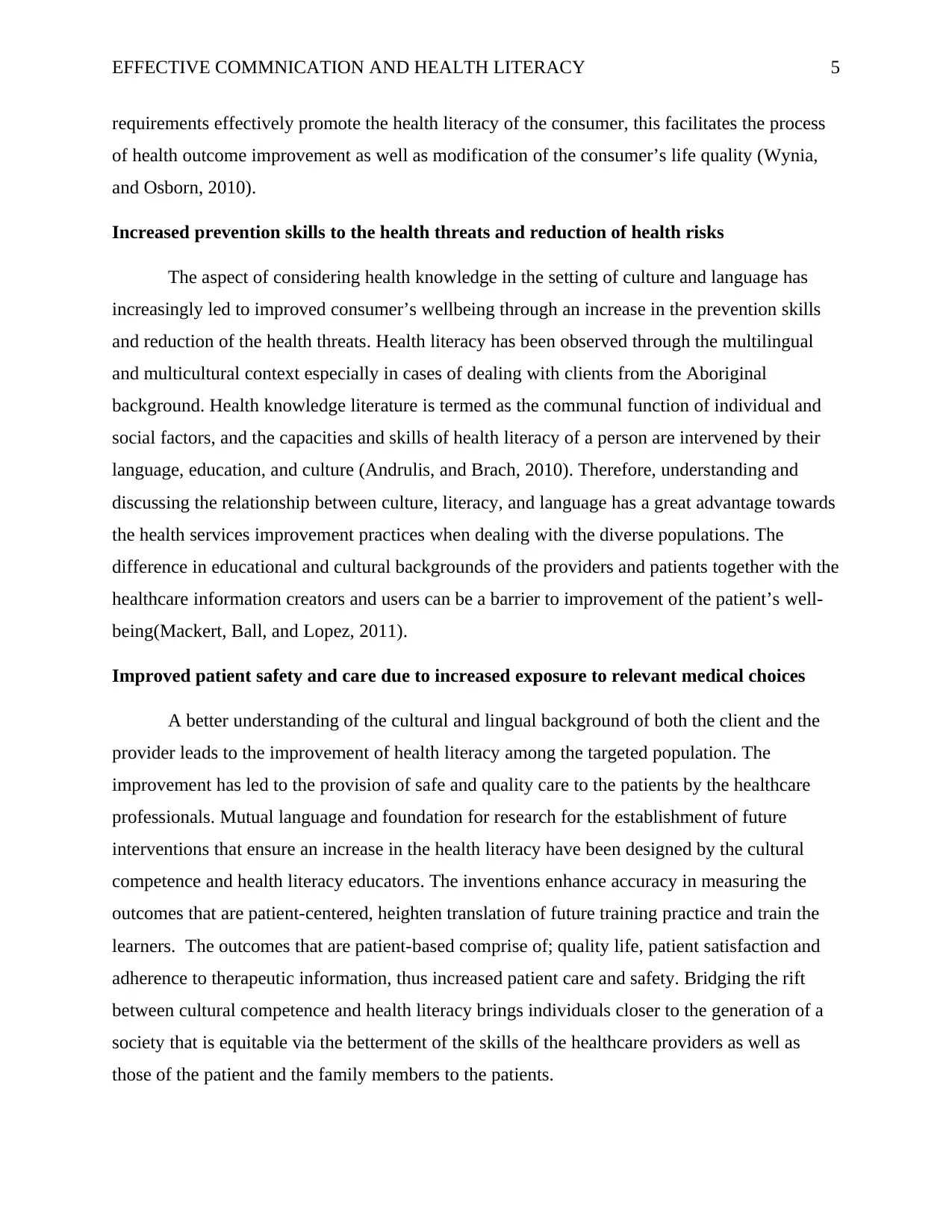
EFFECTIVE COMMNICATION AND HEALTH LITERACY 5
requirements effectively promote the health literacy of the consumer, this facilitates the process
of health outcome improvement as well as modification of the consumer’s life quality (Wynia,
and Osborn, 2010).
Increased prevention skills to the health threats and reduction of health risks
The aspect of considering health knowledge in the setting of culture and language has
increasingly led to improved consumer’s wellbeing through an increase in the prevention skills
and reduction of the health threats. Health literacy has been observed through the multilingual
and multicultural context especially in cases of dealing with clients from the Aboriginal
background. Health knowledge literature is termed as the communal function of individual and
social factors, and the capacities and skills of health literacy of a person are intervened by their
language, education, and culture (Andrulis, and Brach, 2010). Therefore, understanding and
discussing the relationship between culture, literacy, and language has a great advantage towards
the health services improvement practices when dealing with the diverse populations. The
difference in educational and cultural backgrounds of the providers and patients together with the
healthcare information creators and users can be a barrier to improvement of the patient’s well-
being(Mackert, Ball, and Lopez, 2011).
Improved patient safety and care due to increased exposure to relevant medical choices
A better understanding of the cultural and lingual background of both the client and the
provider leads to the improvement of health literacy among the targeted population. The
improvement has led to the provision of safe and quality care to the patients by the healthcare
professionals. Mutual language and foundation for research for the establishment of future
interventions that ensure an increase in the health literacy have been designed by the cultural
competence and health literacy educators. The inventions enhance accuracy in measuring the
outcomes that are patient-centered, heighten translation of future training practice and train the
learners. The outcomes that are patient-based comprise of; quality life, patient satisfaction and
adherence to therapeutic information, thus increased patient care and safety. Bridging the rift
between cultural competence and health literacy brings individuals closer to the generation of a
society that is equitable via the betterment of the skills of the healthcare providers as well as
those of the patient and the family members to the patients.
requirements effectively promote the health literacy of the consumer, this facilitates the process
of health outcome improvement as well as modification of the consumer’s life quality (Wynia,
and Osborn, 2010).
Increased prevention skills to the health threats and reduction of health risks
The aspect of considering health knowledge in the setting of culture and language has
increasingly led to improved consumer’s wellbeing through an increase in the prevention skills
and reduction of the health threats. Health literacy has been observed through the multilingual
and multicultural context especially in cases of dealing with clients from the Aboriginal
background. Health knowledge literature is termed as the communal function of individual and
social factors, and the capacities and skills of health literacy of a person are intervened by their
language, education, and culture (Andrulis, and Brach, 2010). Therefore, understanding and
discussing the relationship between culture, literacy, and language has a great advantage towards
the health services improvement practices when dealing with the diverse populations. The
difference in educational and cultural backgrounds of the providers and patients together with the
healthcare information creators and users can be a barrier to improvement of the patient’s well-
being(Mackert, Ball, and Lopez, 2011).
Improved patient safety and care due to increased exposure to relevant medical choices
A better understanding of the cultural and lingual background of both the client and the
provider leads to the improvement of health literacy among the targeted population. The
improvement has led to the provision of safe and quality care to the patients by the healthcare
professionals. Mutual language and foundation for research for the establishment of future
interventions that ensure an increase in the health literacy have been designed by the cultural
competence and health literacy educators. The inventions enhance accuracy in measuring the
outcomes that are patient-centered, heighten translation of future training practice and train the
learners. The outcomes that are patient-based comprise of; quality life, patient satisfaction and
adherence to therapeutic information, thus increased patient care and safety. Bridging the rift
between cultural competence and health literacy brings individuals closer to the generation of a
society that is equitable via the betterment of the skills of the healthcare providers as well as
those of the patient and the family members to the patients.
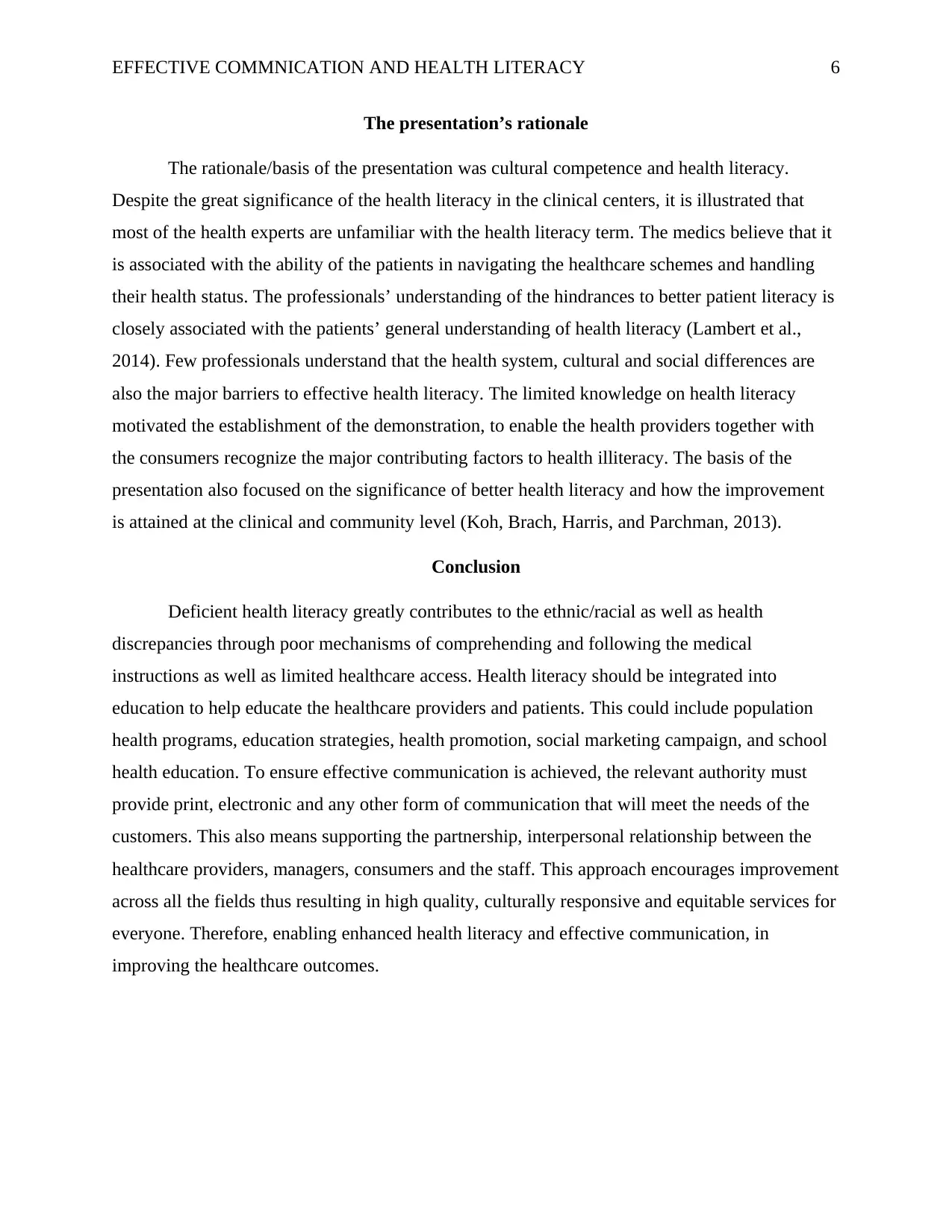
EFFECTIVE COMMNICATION AND HEALTH LITERACY 6
The presentation’s rationale
The rationale/basis of the presentation was cultural competence and health literacy.
Despite the great significance of the health literacy in the clinical centers, it is illustrated that
most of the health experts are unfamiliar with the health literacy term. The medics believe that it
is associated with the ability of the patients in navigating the healthcare schemes and handling
their health status. The professionals’ understanding of the hindrances to better patient literacy is
closely associated with the patients’ general understanding of health literacy (Lambert et al.,
2014). Few professionals understand that the health system, cultural and social differences are
also the major barriers to effective health literacy. The limited knowledge on health literacy
motivated the establishment of the demonstration, to enable the health providers together with
the consumers recognize the major contributing factors to health illiteracy. The basis of the
presentation also focused on the significance of better health literacy and how the improvement
is attained at the clinical and community level (Koh, Brach, Harris, and Parchman, 2013).
Conclusion
Deficient health literacy greatly contributes to the ethnic/racial as well as health
discrepancies through poor mechanisms of comprehending and following the medical
instructions as well as limited healthcare access. Health literacy should be integrated into
education to help educate the healthcare providers and patients. This could include population
health programs, education strategies, health promotion, social marketing campaign, and school
health education. To ensure effective communication is achieved, the relevant authority must
provide print, electronic and any other form of communication that will meet the needs of the
customers. This also means supporting the partnership, interpersonal relationship between the
healthcare providers, managers, consumers and the staff. This approach encourages improvement
across all the fields thus resulting in high quality, culturally responsive and equitable services for
everyone. Therefore, enabling enhanced health literacy and effective communication, in
improving the healthcare outcomes.
The presentation’s rationale
The rationale/basis of the presentation was cultural competence and health literacy.
Despite the great significance of the health literacy in the clinical centers, it is illustrated that
most of the health experts are unfamiliar with the health literacy term. The medics believe that it
is associated with the ability of the patients in navigating the healthcare schemes and handling
their health status. The professionals’ understanding of the hindrances to better patient literacy is
closely associated with the patients’ general understanding of health literacy (Lambert et al.,
2014). Few professionals understand that the health system, cultural and social differences are
also the major barriers to effective health literacy. The limited knowledge on health literacy
motivated the establishment of the demonstration, to enable the health providers together with
the consumers recognize the major contributing factors to health illiteracy. The basis of the
presentation also focused on the significance of better health literacy and how the improvement
is attained at the clinical and community level (Koh, Brach, Harris, and Parchman, 2013).
Conclusion
Deficient health literacy greatly contributes to the ethnic/racial as well as health
discrepancies through poor mechanisms of comprehending and following the medical
instructions as well as limited healthcare access. Health literacy should be integrated into
education to help educate the healthcare providers and patients. This could include population
health programs, education strategies, health promotion, social marketing campaign, and school
health education. To ensure effective communication is achieved, the relevant authority must
provide print, electronic and any other form of communication that will meet the needs of the
customers. This also means supporting the partnership, interpersonal relationship between the
healthcare providers, managers, consumers and the staff. This approach encourages improvement
across all the fields thus resulting in high quality, culturally responsive and equitable services for
everyone. Therefore, enabling enhanced health literacy and effective communication, in
improving the healthcare outcomes.
⊘ This is a preview!⊘
Do you want full access?
Subscribe today to unlock all pages.

Trusted by 1+ million students worldwide
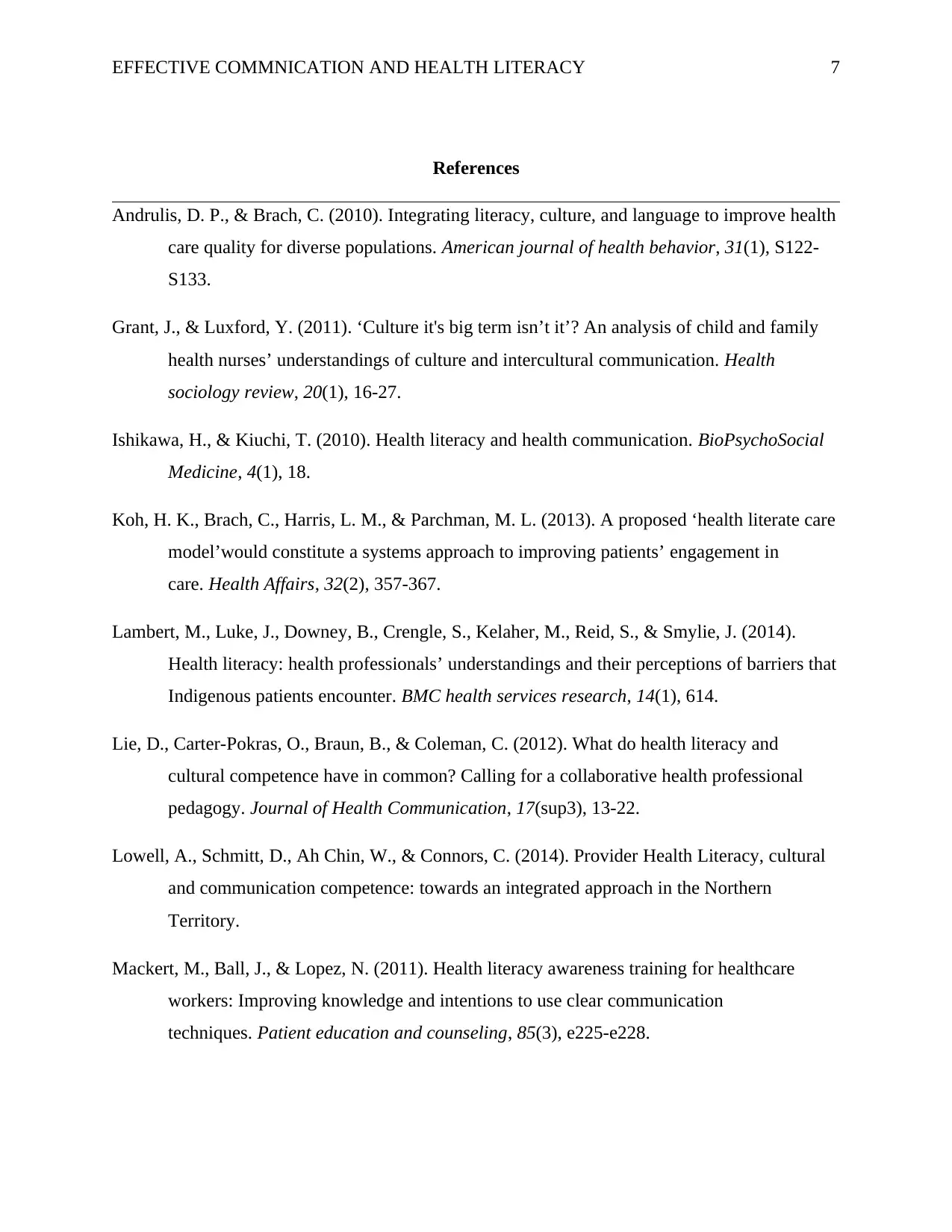
EFFECTIVE COMMNICATION AND HEALTH LITERACY 7
References
Andrulis, D. P., & Brach, C. (2010). Integrating literacy, culture, and language to improve health
care quality for diverse populations. American journal of health behavior, 31(1), S122-
S133.
Grant, J., & Luxford, Y. (2011). ‘Culture it's big term isn’t it’? An analysis of child and family
health nurses’ understandings of culture and intercultural communication. Health
sociology review, 20(1), 16-27.
Ishikawa, H., & Kiuchi, T. (2010). Health literacy and health communication. BioPsychoSocial
Medicine, 4(1), 18.
Koh, H. K., Brach, C., Harris, L. M., & Parchman, M. L. (2013). A proposed ‘health literate care
model’would constitute a systems approach to improving patients’ engagement in
care. Health Affairs, 32(2), 357-367.
Lambert, M., Luke, J., Downey, B., Crengle, S., Kelaher, M., Reid, S., & Smylie, J. (2014).
Health literacy: health professionals’ understandings and their perceptions of barriers that
Indigenous patients encounter. BMC health services research, 14(1), 614.
Lie, D., Carter-Pokras, O., Braun, B., & Coleman, C. (2012). What do health literacy and
cultural competence have in common? Calling for a collaborative health professional
pedagogy. Journal of Health Communication, 17(sup3), 13-22.
Lowell, A., Schmitt, D., Ah Chin, W., & Connors, C. (2014). Provider Health Literacy, cultural
and communication competence: towards an integrated approach in the Northern
Territory.
Mackert, M., Ball, J., & Lopez, N. (2011). Health literacy awareness training for healthcare
workers: Improving knowledge and intentions to use clear communication
techniques. Patient education and counseling, 85(3), e225-e228.
References
Andrulis, D. P., & Brach, C. (2010). Integrating literacy, culture, and language to improve health
care quality for diverse populations. American journal of health behavior, 31(1), S122-
S133.
Grant, J., & Luxford, Y. (2011). ‘Culture it's big term isn’t it’? An analysis of child and family
health nurses’ understandings of culture and intercultural communication. Health
sociology review, 20(1), 16-27.
Ishikawa, H., & Kiuchi, T. (2010). Health literacy and health communication. BioPsychoSocial
Medicine, 4(1), 18.
Koh, H. K., Brach, C., Harris, L. M., & Parchman, M. L. (2013). A proposed ‘health literate care
model’would constitute a systems approach to improving patients’ engagement in
care. Health Affairs, 32(2), 357-367.
Lambert, M., Luke, J., Downey, B., Crengle, S., Kelaher, M., Reid, S., & Smylie, J. (2014).
Health literacy: health professionals’ understandings and their perceptions of barriers that
Indigenous patients encounter. BMC health services research, 14(1), 614.
Lie, D., Carter-Pokras, O., Braun, B., & Coleman, C. (2012). What do health literacy and
cultural competence have in common? Calling for a collaborative health professional
pedagogy. Journal of Health Communication, 17(sup3), 13-22.
Lowell, A., Schmitt, D., Ah Chin, W., & Connors, C. (2014). Provider Health Literacy, cultural
and communication competence: towards an integrated approach in the Northern
Territory.
Mackert, M., Ball, J., & Lopez, N. (2011). Health literacy awareness training for healthcare
workers: Improving knowledge and intentions to use clear communication
techniques. Patient education and counseling, 85(3), e225-e228.
Paraphrase This Document
Need a fresh take? Get an instant paraphrase of this document with our AI Paraphraser
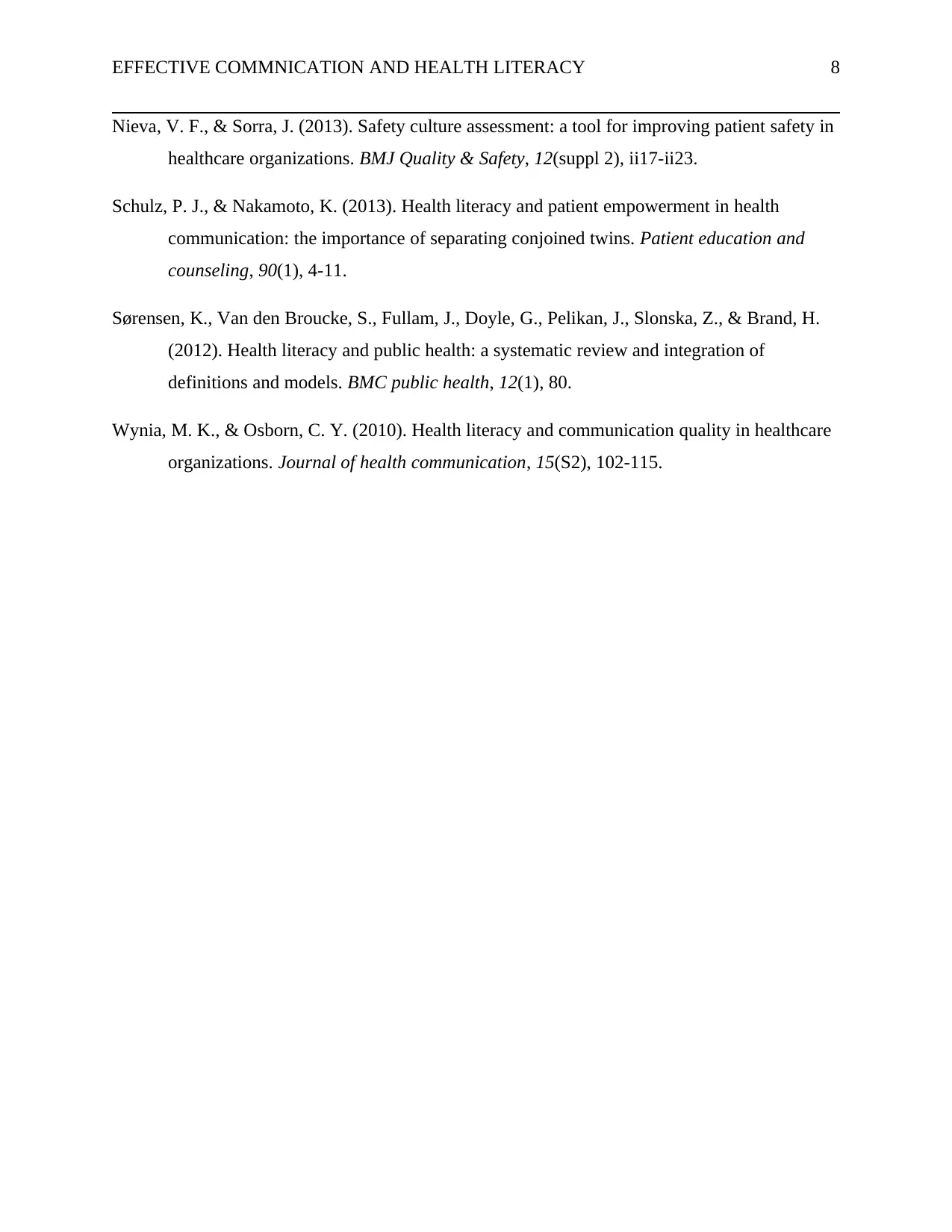
EFFECTIVE COMMNICATION AND HEALTH LITERACY 8
Nieva, V. F., & Sorra, J. (2013). Safety culture assessment: a tool for improving patient safety in
healthcare organizations. BMJ Quality & Safety, 12(suppl 2), ii17-ii23.
Schulz, P. J., & Nakamoto, K. (2013). Health literacy and patient empowerment in health
communication: the importance of separating conjoined twins. Patient education and
counseling, 90(1), 4-11.
Sørensen, K., Van den Broucke, S., Fullam, J., Doyle, G., Pelikan, J., Slonska, Z., & Brand, H.
(2012). Health literacy and public health: a systematic review and integration of
definitions and models. BMC public health, 12(1), 80.
Wynia, M. K., & Osborn, C. Y. (2010). Health literacy and communication quality in healthcare
organizations. Journal of health communication, 15(S2), 102-115.
Nieva, V. F., & Sorra, J. (2013). Safety culture assessment: a tool for improving patient safety in
healthcare organizations. BMJ Quality & Safety, 12(suppl 2), ii17-ii23.
Schulz, P. J., & Nakamoto, K. (2013). Health literacy and patient empowerment in health
communication: the importance of separating conjoined twins. Patient education and
counseling, 90(1), 4-11.
Sørensen, K., Van den Broucke, S., Fullam, J., Doyle, G., Pelikan, J., Slonska, Z., & Brand, H.
(2012). Health literacy and public health: a systematic review and integration of
definitions and models. BMC public health, 12(1), 80.
Wynia, M. K., & Osborn, C. Y. (2010). Health literacy and communication quality in healthcare
organizations. Journal of health communication, 15(S2), 102-115.
1 out of 8
Related Documents
Your All-in-One AI-Powered Toolkit for Academic Success.
+13062052269
info@desklib.com
Available 24*7 on WhatsApp / Email
![[object Object]](/_next/static/media/star-bottom.7253800d.svg)
Unlock your academic potential
Copyright © 2020–2025 A2Z Services. All Rights Reserved. Developed and managed by ZUCOL.





